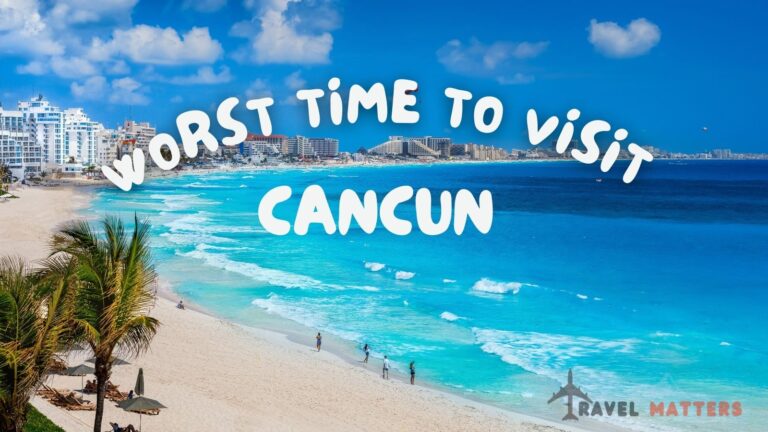When is the Worst Time to Visit St. Thomas
With its swaying palm trees, stunning beaches, and lively island culture, St. Thomas is one of the most popular destinations in the U.S. Virgin Islands. But as an island subject to seasonal changes, there are better and worse times to visit.
This guide will overview St. Thomas’ climate patterns, crowds, costs, and seasonal events to determine the least ideal times for vacationing on the island. By avoiding the worst months, you can have a more enjoyable trip in the Virgin Islands.
Overview of St. Thomas’ Climate and Seasons
St. Thomas enjoys a warm tropical climate all year with hot, humid conditions and two main seasons – high season and low season.
The dry season falls roughly from December to April, bringing drier weather and peak crowds of travelers.
The wet season spans May through November with increased humidity, higher temperatures, and greater chances of rain. Short downpours are common.
Hurricane season officially runs from June to November, with the biggest risks in August, September, and October when major storms can impact the islands.
Temperatures stay consistent averaging around 29°C (84°F) year-round. The water temperature hovers around 27°C (80°F) making swimming comfortable any time.
You May Also Like:
Avoid Peak Crowds and Costs
Like many Caribbean destinations, St. Thomas sees its largest influx of visitors during the winter high season from mid-December to mid-April. This is the most popular yet crowded time to visit.
- December to April has ideal dry weather but is extremely busy. Hotel rates and airfares skyrocket.
- Christmas, New Year, and Spring Break require booking very early as availability is scarce.
- January to March has peak crowds from winter travelers. Beaches, attractions, and restaurants overflow.
- February and March still see 90% hotel occupancy rates despite costs decreasing from the holidays.
For the smallest crowds and prices, avoid traveling during the high season. The island loses its laidback charm when teeming with tourists.
Skip the Wettest Weather
St. Thomas‘ wet season spans May through November, bringing hotter weather, higher humidity, and increased chances of rain.
While brief showers occur year-round on the island, they become more frequent and heavier during these months. The odds of rain are highest from May to early June and late August to November.
September and October see the most rainfall and storm threats as the peak months of hurricane season. Travel is not advised during this period due to the risks of major storms.
If you don’t want to risk wetter weather, skip visiting St. Thomas from late August through early winter when rain is most persistent because it can be the worst time to visit St. Thomas.
Avoid Hurricane Season
The Atlantic hurricane season officially lasts from June 1 to November 30, encompassing St. Thomas’ entire wet season. But the greatest dangers exist from late August through October.
Powerful tropical storms have the highest probability of impacting St. Thomas and causing major damage during this peak hurricane timeframe.
It’s hard to predict exact storm dates and tracks so far in advance. However, visiting in September and October does come with a lot more risk of cancellations, delays, and closures.
For the best chance of clear skies, plan your trip outside of the peak hurricane season months.

Steer Clear of Major Events
St. Thomas hosts various annual events and festivals that significantly drive up hotel rates and crowds on the island. It’s best to avoid traveling during the busiest occasions.
Some of the major annual events in St. Thomas include:
- St. Thomas Carnival – April and May
- 4th of July Celebration – Early July
- St. Thomas International Regatta – Late March/Early April
- St. Thomas/St. John Agriculture & Food Fair – Late April
- Virgin Islands Open/Atlantic Blue Marlin Tournament – Late October
Research any big festivals or conventions happening during your travel dates, as hotel availability plummets. Unless you want to join the actual event, give these crowded peak times a miss.
The Worst Time to Visit St. Thomas
Taking weather, crowds, and prices into account, the combination of September through early November is generally the worst time to visit St. Thomas:
- Rainy season is ongoing with high humidity, muggy heat, and frequent showers.
- September and October fall within the peak hurricane threat period.
- Low season means smaller crowds but resorts/restaurants may have limited operation or outright close.
- Some flights and ferries operate on reduced schedules.
- Hotel rates aren’t high but availability can still be limited.
- Popular beaches and attractions are less packed which can be a pro.
While off-season travel can often yield deals, weather concerns, and closures during this period make it a risky time to plan a St. Thomas vacation.
For ideal weather, costs, and full operation, it’s better to travel outside the early fall months.
Read More: When is the worst time to visit Greece
The Best Times to Visit St. Thomas
Want to avoid worst time to visit St. Thomas & to experience St. Thomas at its finest, target:
- Mid-April to early June – Pleasant temperatures before the rainy season.
- Early to mid-December – Before holiday crowds and high rates kick in.
- Late November – Drier weather and calm winds return.
During these shoulder season months, you’ll enjoy:
- Warm weather with low chances of rain.
- Smaller crowds and plenty of hotel availability.
- Lower airfares and hotel rates.
- Major resorts and restaurants are open fully.
- No risk of major storms or hurricanes.
- Popular beaches and attractions are less crowded.
Aim for a spring or early winter trip to soak up the island vibes without fighting peak-season crowds and prices.
Tips for Visiting in the Wet Season
If you can only travel to St. Thomas during wet months, here are some tips:
- Book hotels and flights early before they fill up.
- Pack for tropical humidity as well as rain.
- Have indoor activities like spas, shopping, and museums in your plans as backups.
- Consider lower rain-risk areas like Water Island or the East End.
- Get trip insurance in case a storm interrupts travel.
- Follow weather forecasts closely to plan activities accordingly.
- Avoid September/October to steer clear of hurricane season peak.
- Take advantage of lower rates and smaller crowds.
With the right preparations and realistic expectations, you can still enjoy St. Thomas during its wet season. Just be ready to adjust your plans around the rain.
Frequently Asked Questions
What is the wet season in St. Thomas?
The wet season in St. Thomas lasts from May through November, with more rain likely starting in May. September and October see the most rainfall.
When does hurricane season peak in St. Thomas?
The peak hurricane threat period in St. Thomas is late August through October when major storms are most likely to impact the islands.
When are prices highest in St. Thomas?
Prices are highest during the busy winter high season from mid-December through mid-April, especially around the holidays. Hotel rates jump and airfares climb significantly.
Is September a bad time to visit St. Thomas?
Yes, September is a risky month to visit St. Thomas due to very heavy rainfall and prime hurricane season conditions with the potential for major storm impacts.
When are crowds the smallest in St. Thomas?
The smallest crowds are found during the wet season from May to mid-December, outside of the busy dry winter season. May and November have lower rain chances than fall months.






